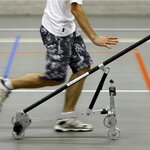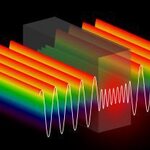Applied Physics

You know this already - given sufficient forward speed, a bicycle pushed sideways will not fall over.
Since the bicycle was invented, scientists have postulated various reasons as to why a bicycle is self stable above a certain speed. The consensus has been that a bicycle's stability is related to two factors: First, the rotating wheels of the bicycle provide stability through gyroscopic effects; secondly, that the ‘trail’, the distance by which the contact point of the front wheel trails behind the steering axis, plays an important part. A new study in Science claims to…

Entanglement, the quantum mechanical phenomenon, was coined as a term by Erwin Schrödinger in 1935 but is still not understood completely. From an applied perspective, while entangled particles cannot be defined as single particles with defined states but are instead a whole system, that means by entangling single quantum bits, a quantum computer should solve problems considerably faster than conventional computers.
But understanding entanglement when there are two particles is tough enough. When there are many, it's even trickier, but a new experiment in the…

Future firefighters may use electricity instead of water to control flames, according to results of a discovery that could underpin a new genre of fire-fighting devices, including 'sprinkler' systems that suppress fires not with water, but with zaps of electric current.
In the study, researchers connected an electrical amplifier to a wand-like probe and used the device to shoot beams of electricity at an open flame more than a foot high. Almost instantly, the flame was snuffed out. The device consisted of a 600-watt amplifier, about the same power as a high-end car stereo…

South Korea has agreed to send some 50 tons of boron from its reserves to Japan to help fight the nuclear disaster at the Fukushima reactor plant.
The scientists at TEPCO have been sent samples for analysis and a decision should be made pretty quickly. [Reuters, Korea Herald]
However, this seems to have been lightly reported and I blog this here more in the hope of an answer to a niggling question I've had since the start of this tragedy. Why have the operators at Fukushima not used boron carbide to absorb neutrons rather than boric acid? It seems as if, for whatever reasons, liquid boron is…

If you have a chance to win a basketball game but need to make a shot from 10 feet away on the right side of the court, do you try a direct shot or use the backboard to bank home the winning basket?
New research by engineers at North Carolina State University, done by simulating one million shots with a computer, has them declaring you have a better chance of scoring that particular game-winning bucket with a bank shot than with a direct shot.
The bank shot can be 20 percent more effective when shooting at many angles up to a distance of about 12 feet from the basket, they say. Bank…

While wireless Internet has been wonderful, true wireless devices - with no need for batteries - are the real revolution needed in technology to make a more positive environmental scenario for the future.
We're getting closer. A doctoral student at Rensselaer Polytechnic Institute has demonstrated a new system that uses ultrasound to simultaneously transmit large quantities of data and power wirelessly, even through thick metal walls like the hulls of ships and submarines.In the area of defense, a progression from wired to wireless systems presents an opportunity to improve…

Seismic sections are usually subjected to some processing sequence for noise reduction. If the noise has appreciable energy outside the frequency range of the useful signal, these sequences are effective and if accurate NMO and STATIC are done, data cluster after stack can be greatly reduced. Spectrum of noise however do overlaps the signal spectrum and 100% noise removal is difficult and because interference affects the seismic response of acquisition system for closely spaced boundaries, these lead to data cluster and biased seismic section prior to migration.
In this paper, a simple…

After 50 years, laser technology is still advancing. Scientists at Yale University have announced the world's first anti-laser, in which incoming beams of light interfere with one another in such a way as to perfectly cancel each other out, a breakthrough that sounds academic but could pave the way for new applications in optical computing and radiology.
Conventional lasers, which were first invented in 1960, use a so-called "gain medium," usually a semiconductor like gallium arsenide, to produce a focused beam of coherent light—light waves with the same frequency and amplitude…

A short while ago, SciFest 2010, the International Science Festival, was held in St. Louis. Making the trip was a group from Jersey Shore, PA and they were invited because a teacher, Slater Harrison, is really good at 'air surfing'.
If you have never seen the term air surfing, it was invented in the 1970s by Dr. Tyler MacCready, a fellow who studied philosophy at Yale and then geology at the University of Wyoming and Monash before becoming famous in amateur aerodynamics for the 'walkalong glider' - which looks like magic to many a young person's eyes, at least the way Harrison and his…

In 2010 there was an impressive increase in the number of Chartered Engineer registrations with the Institution of Mechanical Engineers, my own Institution, leading the way.
The number of Chartered Engineers registered last year was 26% more than in 2009 and 1,135 of those were through the IMechE, the highest number of all the Institutions.
A surprising statistic was that the average age of engineers achieving Chartered status was 36. Engineering at that level requires experience and maturity in addition to a high level of academic achievement, these days reckoned to take eight to ten years…